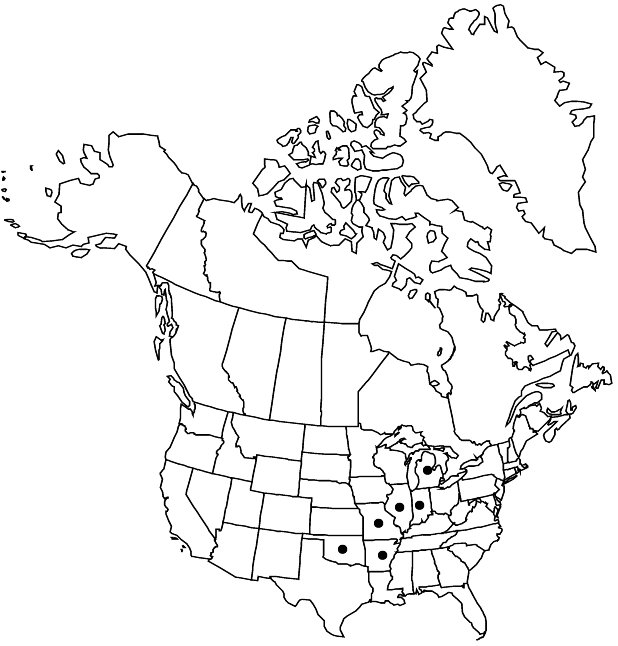Difference between revisions of "Heuchera americana var. hirsuticaulis"
Minnesota Stud. Pl. Sci. 2: 60. 1936,.
FNA>Volume Importer |
FNA>Volume Importer |
||
| Line 6: | Line 6: | ||
|place=2: 60. 1936, | |place=2: 60. 1936, | ||
}} | }} | ||
| − | |basionyms={{Treatment/ID/ | + | |basionyms={{Treatment/ID/Basionym |
|name=Heuchera hispida var. hirsuticaulis | |name=Heuchera hispida var. hirsuticaulis | ||
|authority=Wheelock | |authority=Wheelock | ||
| + | |publication_title=Bull. Torrey Bot. Club | ||
| + | |publication_place=17: 199. 1890 | ||
}} | }} | ||
|synonyms={{Treatment/ID/Synonym | |synonyms={{Treatment/ID/Synonym | ||
| Line 31: | Line 33: | ||
|elevation=200-400 m | |elevation=200-400 m | ||
|distribution=Ark.;Ill.;Ind.;Mich.;Mo.;Okla. | |distribution=Ark.;Ill.;Ind.;Mich.;Mo.;Okla. | ||
| − | |discussion=<p>Variety hirsuticaulis occurs in a band from Oklahoma to Michigan, where <i></i>var.<i> americana</i> and <i>Heuchera richardsonii</i> overlap; it is intermediate between those taxa in floral characters but is densely long stipitate-glandular like <i>H. richardsonii</i>. It is probably the result of introgression from <i>H. richardsonii</i> from as long ago as the Pleistocene migrations. Data from a breeding study involving the two species showed a tendency for the shorter hypanthium of <i></i>var.<i> americana</i> to dominate in the artificial hybrids between <i>H. americana</i> and <i>H. richardsonii</i> (E. F. Wells 1979).</p> | + | |discussion=<p>Variety hirsuticaulis occurs in a band from Oklahoma to Michigan, where <i></i></i>var.<i><i> americana</i> and <i>Heuchera richardsonii</i> overlap; it is intermediate between those taxa in floral characters but is densely long stipitate-glandular like <i>H. richardsonii</i>. It is probably the result of introgression from <i>H. richardsonii</i> from as long ago as the Pleistocene migrations. Data from a breeding study involving the two species showed a tendency for the shorter hypanthium of <i></i></i>var.<i><i> americana</i> to dominate in the artificial hybrids between <i>H. americana</i> and <i>H. richardsonii</i> (E. F. Wells 1979).</p> |
|tables= | |tables= | ||
|references= | |references= | ||
| Line 55: | Line 57: | ||
|publication year= | |publication year= | ||
|special status= | |special status= | ||
| − | |source xml=https://jpend@bitbucket.org/aafc-mbb/fna-data-curation.git/src/ | + | |source xml=https://jpend@bitbucket.org/aafc-mbb/fna-data-curation.git/src/f6b125a955440c0872999024f038d74684f65921/coarse_grained_fna_xml/V8/V8_183.xml |
|genus=Heuchera | |genus=Heuchera | ||
|species=Heuchera americana | |species=Heuchera americana | ||
Revision as of 20:28, 24 September 2019
Petioles densely long stipitate-glandular. Flowers: hypanthium free 1.1–2 mm, campanulate; petals greenish, white, or pink, narrower than sepals, margins nearly entire or finely dentate. 2n = 14.
Phenology: Flowering Apr–Jun.
Habitat: Rich woods or open grasslands often over base-saturated granite and gneiss, or in shallow rocky soil
Elevation: 200-400 m
Distribution

Ark., Ill., Ind., Mich., Mo., Okla.
Discussion
Variety hirsuticaulis occurs in a band from Oklahoma to Michigan, where var. americana and Heuchera richardsonii overlap; it is intermediate between those taxa in floral characters but is densely long stipitate-glandular like H. richardsonii. It is probably the result of introgression from H. richardsonii from as long ago as the Pleistocene migrations. Data from a breeding study involving the two species showed a tendency for the shorter hypanthium of var. americana to dominate in the artificial hybrids between H. americana and H. richardsonii (E. F. Wells 1979).
Selected References
None.